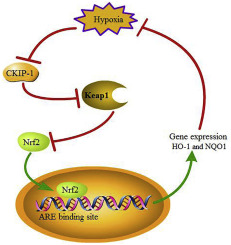Biochimie ( IF 3.3 ) Pub Date : 2019-06-12 , DOI: 10.1016/j.biochi.2019.06.008 Jie Ren , Jingjin Li , Jingwen Hu , Hang Yu , Qian Yang , Jianjun Mu

|
Acute myocardial infarction causes irreversible myocardial damage and is a leading cause of death and disability worldwide. Casein kinase 2 interacting protein-1 (CKIP-1) has been suggested to confer cytoprotection against various pathologic injuries. However, it remains unclear whether CKIP-1 regulates myocardial infarction-induced cardiomyocyte injury. This study aimed to explore the potential role of CKIP-1 in regulating hypoxia-induced cardiomyocyte injury and reveal the underlying mechanism. The results demonstrated that hypoxia-exposed cardiomyocytes showed lower CKIP-1 expression. CKIP-1 restoration by transfecting a CKIP-1 expression vector significantly improved viability and reduced apoptosis in hypoxia-treated cardiomyocytes. Moreover, CKIP-1 overexpression suppressed hypoxia-induced oxidative stress in cardiomyocytes. Mechanism research revealed that CKIP-1 overexpression reduced the expression of kelch-like ECH-associated protein 1 (Keap1) and increased the nuclear translocation of nuclear factor E2-related factor 2 (Nrf2), actions which resulted in an increase in the transcription of Nrf2 target genes. However, Keap1 overexpression partially reversed CKIP-1-mediated Nrf2 promotion and cardioprotection. Notably, the blockade of Nrf2 signaling also significantly abolished CKIP-1-mediated cardioprotection. Overall, our findings demonstrate that CKIP-1 alleviates hypoxia-induced cardiomyocyte injury through the up-regulation of Nrf2 antioxidant signaling via the down-regulation of Keap1, suggesting a potential role for CKIP-1 in myocardial infarction.
中文翻译:

CKIP-1的过表达通过通过Keap1抑制上调Nrf2抗氧化信号来减轻缺氧诱导的心肌细胞损伤
急性心肌梗塞会导致不可逆转的心肌损害,是全球范围内死亡和致残的主要原因。酪蛋白激酶2相互作用蛋白1(CKIP-1)已被建议赋予针对各种病理损伤的细胞保护。但是,尚不清楚CKIP-1是否调节心肌梗死诱发的心肌细胞损伤。这项研究旨在探讨CKIP-1在调节缺氧诱导的心肌细胞损伤中的潜在作用并揭示其潜在机制。结果表明,低氧暴露的心肌细胞显示较低的CKIP-1表达。通过转染CKIP-1表达载体来恢复CKIP-1,可显着提高缺氧处理过的心肌细胞的活力并减少其凋亡。此外,CKIP-1的过表达抑制了心肌细胞缺氧引起的氧化应激。机制研究表明,CKIP-1的过表达降低了海切尔样ECH相关蛋白1(Keap1)的表达,并增加了核因子E2相关因子2(Nrf2)的核易位,其作用导致了ERK相关蛋白2的转录增加。 Nrf2靶基因。但是,Keap1过表达部分逆转了CKIP-1介导的Nrf2促进和心脏保护作用。值得注意的是,对Nrf2信号的阻断也大大消除了CKIP-1介导的心脏保护作用。总体而言,我们的研究结果表明CKIP-1通过下调Keap1的Nrf2抗氧化剂信号的上调来减轻缺氧诱导的心肌细胞损伤,提示CKIP-1在心肌梗死中的潜在作用。











































 京公网安备 11010802027423号
京公网安备 11010802027423号